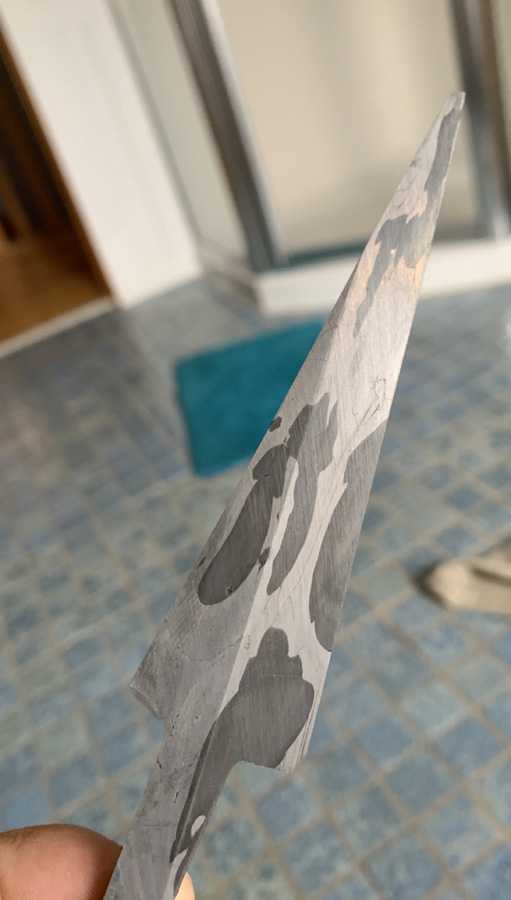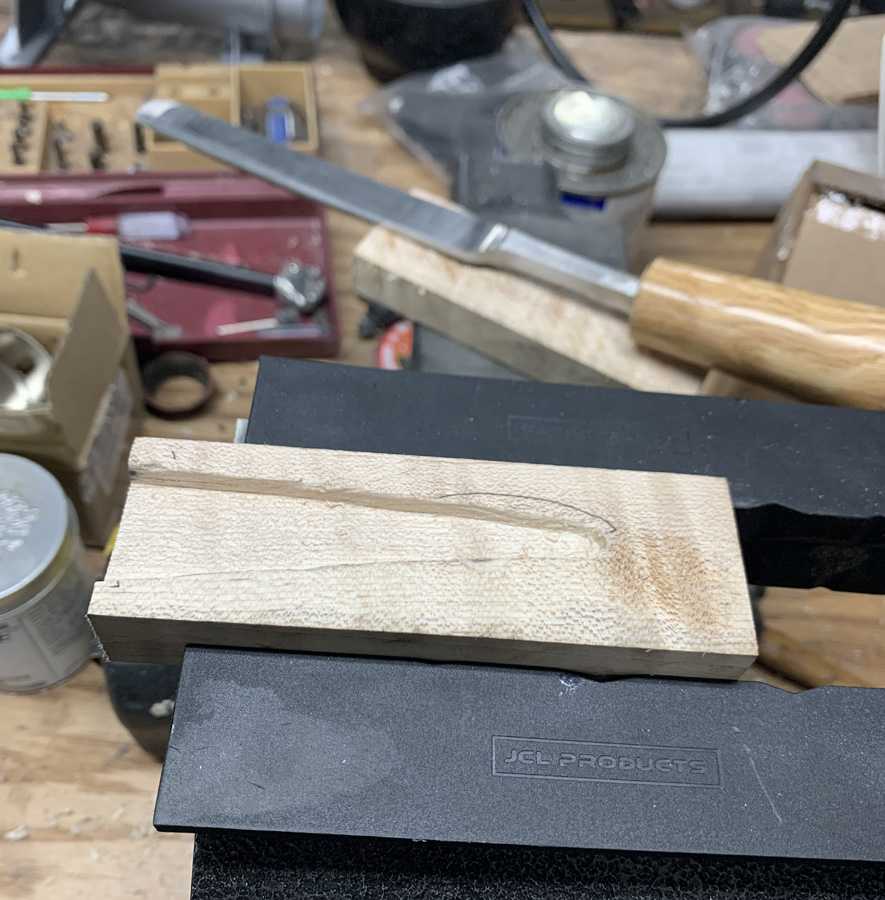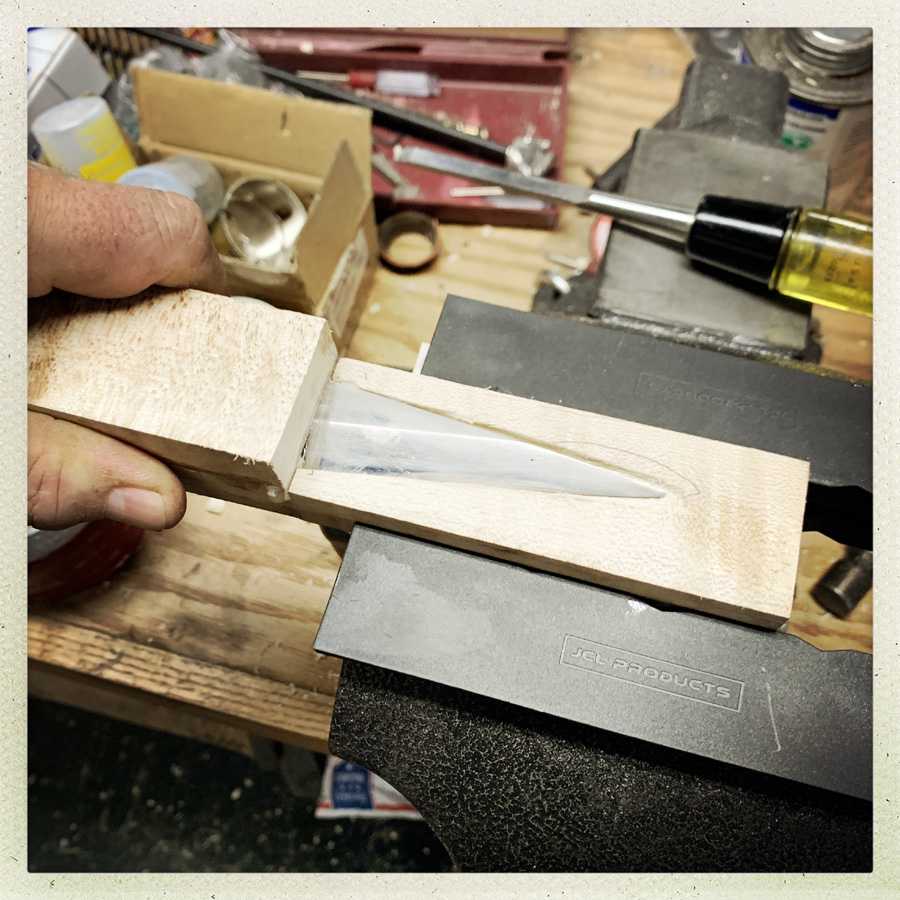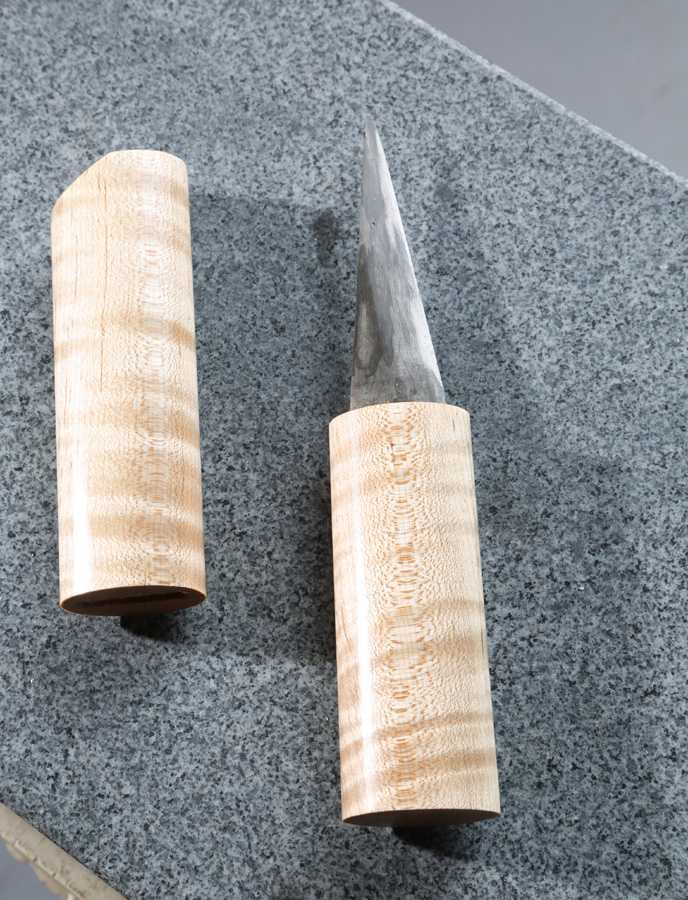kestrel mentioned that she’s learning how to graft plants and trees, and that her friend who is demonstrating the process misplaced their knife. Well, that’s sure to get my attention.
I don’t know what western grafting-knives look like, but Japanese ones are familiar. When I was in college I picked up a Japanese knife at a thrift sale in San Francisco; it was really cool-looking and I carried it in my jacket sleeve for years. Then, it went into a trunk with other knives (what, don’t you have entire trunks full of knives?) and later found employment as a marking knife for woodworking. The edge is a very hard, very fine steel – I believe now that it’s what’s called “Hitachi Blue Paper #1” which is a high carbon steel that Hitachi only sells to the Japanese market. It’s really magnificent stuff and takes an absurd edge (although a lot of that has to do with the grind).

I didn’t know it was a grafting-knife until I was researching kiridashi a couple years ago. So, kestrel needed a grafting-knife and I had a great example of one. Simple.
I had just welded down a small bar of motorcycle chain, which I welded onto a piece of 1095 and formed into a blade. This took relatively little effort:

That’s what it looks like polished and parkerized. I felt that the parkerizing was a bit too dramatic and polished it back down to a fine satin shine.
Then, I let it sit on the bench for a while, because I was not feeling the urge to do the handle and case. That sort of wooden case is tricky and, sure enough, I didn’t do a great job of it; there are flaws. The way you make a case/handle like that is by cutting a block of wood in 4, as precisely as possible, then inletting the tang in one side and the blade in the other. Then everything gets epoxied together and the resulting rectangular block gets shaped on a belt sander. Pro tip: put a thin layer of camellia oil or vaseline on the blade when you do the glue-up, so that if any glue squeezes onto the blade, it doesn’t produce a permanent bond.
This time, unfortunately, a bit of epoxy squeezed out the front of the handle, which I had to shave off with a chisel, then sand the marks off. The result of that is that the face of the handle was no longer perfectly flat, so when the blade is in the case there is a visible gap. Since the case was already shaped and inletted, I couldn’t take material from the face of the case to make the fit better, because there was a chance that I’d shorten the case enough that the blade would no longer fit. Basically, it’s “what you get is what you get…”
You may perhaps recall the tragic tale of my saya nomi (case chisel) [stderr] – I finished it with an oak handle turned on the lathe; it’s ridiculously easy to make handles now, so long as they are round. I threaded the end of the tang and made a strike-plate out of a chunk of damascus gooby, so that if I need to, I can tap the heel of the chisel with a little mallet to make it cut. Traditionally, Japanese sword-cases are ash or magnolia (“ho”) wood; something light and fairly soft, so being able to hammer on the chisel is usually not necessary. In spite of the problem with the damascus and forging, the saya nomi turned out very well and works very well. It’s kind of scary to push a chisel like that at hard wood like maple – if I slip and catch myself with it, it’ll chisel bone much easier than maple.

The chisel produces a beautiful, smooth cut. I’m very pleased with how well it works.

Everything must fit as tightly as possible but not too tightly. It’s a matter of trial and refinement.

I don’t understand how my mind works: I am quite happy to make endless fiddly adjustments to a bar of steel using a grinder, but I get bored quickly when I am fitting wood. Perhaps its because wood is so easy to screw up. Steel is a lot tougher.
One nice touch to the Japanese knife I have, is the way the end of the case is shaped so you can tell which way the blade goes in. I did the same.

Maple is pretty but you have to handle it carefully so as not to get grease or whatever in the pores of the wood.
Done, with a satin finish on the blade and a partial parkerized finish.

The blade and the case/handle will age and darken, which is as it should be. Overall I am satisfied with how it turned out, but the handle/case fit is not perfect and the glue-line of the epoxy is visible because the wood is so bright. One other flaw: I quenched the blade in cold salt water, to give it maximum hardness, and it sure came out hard! It’s a little too hard, maybe; the edge of the blade is kind of crispy – it’s wicked sharp and quite strong but the edge wants to chip slightly. In retrospect, I wish I had dipped into my precious supply of Hitachi Blue Paper #1 and welded a strip of it along the edge of the motorcycle chain instead of using 1095. That would have been risky, because the motorcycle chain wants to bend in all sorts of strange ways when you quench it, and the resulting blade probably held up better because of the big slab of 1095 welded on one side of it. I’ll never know, because I probably won’t repeat the experiment.

Now we can all join in nagging kestrel to post pictures of her grafting projects over at Affinity.

Marcus it may not be perfect, but it is beautiful, and I am sure kestrel will enjoy using it.
You guys, this knife is amazing and I can’t wait to get tree sap all over it. It is SO GORGEOUS. And feels wonderful in the hand…
On flaws: in our quilting group (that is no more, alas) we would say that if your quilt was out on the porch and a man riding by on a horse could not spot the flaw, it probably wasn’t worth worrying about. The important thing about this knife is: 1. It is incredibly sharp, and 2. It will work for the job it’s intended for. I can pretty much guarantee that not one person who looks at this knife is going to say, “Oh hey – there is a very tiny gap in how that fits together”. In my excitement I’ve already shown it to everyone who has come to the house (not that many, admittedly) who probably wonder why on Earth I would show them a grafting knife, and today I’m meeting some friends to exchange chicken eggs and I’ll show it to them too. They will probably wonder the same thing but I really doubt anyone is going to notice that tiny gap.
That looks amazing. My grandpa used to carry a pocket knife for grafting. I think there should still be a few cherry trees in the meadows where he just tried and then waited to see if it worked.
Beautiful. I’m sure kestrel will get much good use and enjoyment from the knife and Affinity will happily post any photos she wishes to share.
One of the things that strikes me about your art is how flexible you seem to be in drawing from different styles.
The two knives I rely on most are both Michael Hemmer knives, also a small-volume artist, rather than any kind of mass-produced line of knives. I love them and the handle fits my arthritic hands in ways that other knives simply can’t match. (Although I’d love to try a handle like these six, from charly.)
But as much as I love them, if you search for Hemmer’s website, you’ll find that all the knives look the same. They’re beautiful, and well made, but they’re all the same. Every time I see you working on a knife project, it seems to be something new. That’s a special kind of special.
P.S. I should probably also be impressed with charly’s work for the same reason, but I haven’t read as many posts about charly’s work as I have about Marcus’ work, so I’ll just say I’m not trying to slight charly and try to keep up with the posts at Affinity better in the future.
Crip Dyke, Right Reverend Feminist FuckToy of Death & Her Handmaiden@#5″
One of the things that strikes me about your art is how flexible you seem to be in drawing from different styles.
Thank you. What I am doing is trying to broaden my experience and learn many different things, which is where I have the most fun. I’m not doing this for money so I don’t need to find a niche and occupy it, which is an unfortunate situation for a lot of artists. (Did Caravaggio ever look at a canvas and sigh, “I suppose I have to do one of those contrasty things again…” Not that I liken myself to Caravaggio! But, as Ray Wylie Hubbard says “the most important thing about song-writing is when you write a song ask yourself “can I play this for 45 years?”)
But as much as I love them, if you search for Hemmer’s website, you’ll find that all the knives look the same. They’re beautiful, and well made, but they’re all the same.
It’s a very distinctive style and he probably has people who’d complain if he stopped and started doing something else. Remember when Bob Dylan refused to continue playing acoustic guitar and his fans freaked out? A lot of the times it seems to me that a ‘creative rut’ is ‘meeting people’s expectations.’
That’s a special kind of special.
It’s probably “a great coping mechanism for undiagnosed ADHD” But thank you!